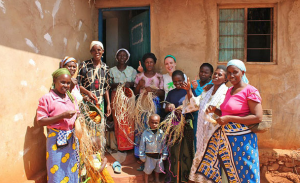A Journey into REDD+: Wildlife Works Kasigau Corridor REDD+ Project, Kenya
By Rachel O’Reilly, part of the Wildlife Works Carbon Business Development team
This October, I was assigned to visit our REDD+ (Reducing Emissions from Deforestation and Degradation) project in Kenya to document the essence of the project through imagery with world-renowned “cause-related” photographer, Lisa Kristine. Lisa’s work is focused on the vast diversity and hardships of humanity, resulting in photos that connect audiences to the dignity that exists in us all, regardless of the conditions.
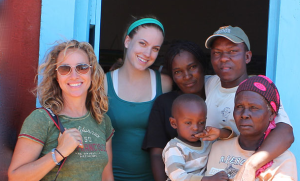
The Wildlife Works Kasigau Corridor REDD+ project is located between Tsavo East and Tsavo West National Parks in Kenya. It acts as a vital wildlife corridor for a fantastic diversity of over 50 species of large mammals, more than 300 species of birds and important populations of IUCN Red List endangered and vulnerable species including Grevy’s zebra, cheetah, lion, African wild dog as well as over 2000 African elephants—a population that grows increasingly fragile due to the profitable crime of ivory poaching.

We embarked on a journey through REDD+ that would capture the essence of the community, the astonishing landscape and wildlife, and the overall impact our project has had. This journey was far more humbling and insightful than I had anticipated…
After a long flight with several stops from San Francisco and a couple hours on the Trans-African highway from Mombasa, I finally arrived at the Wildlife Works headquarters, deep in the Kenyan bush. The Wildlife Works office is a scene in complete contrast to its surroundings: a dozen people hunch over laptops at a desk, while others host a meeting outside under a tarp shade structure, and young interns from the surrounding areas work on the community newsletter which is distributed regularly in several languages to ensure everyone is informed of the project’s happenings.

This is command central where Rob Dodson, our VP of African Operations, and his team are the epicenter of things happening for our Kasigau REDD+ project. Operations include monitoring and measuring the forest and wildlife; community outreach; and special initiative planning like agricultural intensification, sustainable charcoal, cash crops, reforestation, and water projects—ALL of this for an area of 500,000 acres and a community of about 100,000 people is happening here! I’m in awe of how incredible it is that a modest, single-level structure in the bush with a slow satellite internet connection houses the work of such bright and dedicated people from the local community and around the world.
The searing sun
To ensure maximum time in the bush to capture photos of the many incredible creatures that roam the area, we woke the next day at 4:30am for a dawn game drive with Alfred, our guide. The stillness of the earth at the break of day was met by the increasing chorus of African birds as dawn arose.
As we drove through the community on our way to more remote areas, we saw a few families up early, preparing food over open flames outside of their traditional homes made of mud, stick, and dung, while others were getting an early start fetching water before the blistering sun made it an even more laborious task.
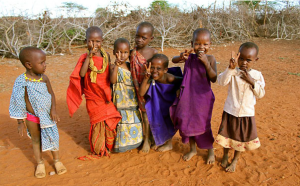
Lack of water is the main underlying cause of deforestation and poverty in the region. Families who are unable to produce a small crop on one plot of land because of dry soil due to lack of water will cut down a neighboring area of forest in hopes that the next plot of land will provide a better harvest.
There is a major watershed with a pipeline that runs from a mountain spring close to the area, to the coastal city of Mombasa. It passes right by many of the people in the local community, but most of the people have no access to it because the pipes attached to this pipeline degraded years ago and no one, including the government, has been able to fund the restoration. Throughout our stay, Lisa and I bore constant witness to the thousands of people living with the burden of walking miles each day to the nearest water tank to meet their most basic need.
The communities have the right to construct a pipeline from the main pipe to supply the entire community with water. Financing is becoming available through proceeds received from the REDD+ project, so they have decided to use a large percentage of the REDD+ funds they receive to resolve this pressing issue.
Conservation battlefield
Continuing on our trek, Lisa, Alfred and I bumped along keenly peering into the bush for any movement. At last we came upon not one, but five giraffes! They were in a clearing, so we could see the full form of their beautiful geometric patterns from their skinny knee-knocking posture up to their graceful necks, long eyelashes, and reaching black tongues. Instead of being spooked and darting into the bush, this family had one member watch us while the others focused on eating breakfast.

As the sun illuminated the savannah, we continued our search and sadly came upon two baby elephant carcasses near a watering hole. These elephants were victims of a lion attack a few days before. While we were somewhat reassured by the fact that this was a natural cause of death, Alfred noted that these babies were probably made vulnerable to the lion’s attack because their mothers had been some of the increasing number of elephant fatalities at the hands of ivory poachers.
Rust colored dust began to rise through the short gray branches around the watering hole and into view came the curly wide horns of the African buffalo. Dozens of the robust creatures sauntered towards the water while small yellow-billed oxpecker birds perched on the buffalo for a ride. Zebras followed and eventually a family of warthogs decided to join in the gathering by jumping into a wide muddy ditch made possible by a leak in the water trough.
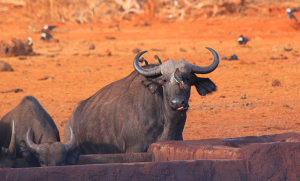
Peace rangers
We continued our drive to meet with the Wildlife Works rangers stationed at one of the most remote posts at the base of Mt. Rukinga known as “6 zero.” Lisa photographed the rangers doing their usual routines and running through the bush as they do when tracking poachers. We had a special photo shoot for the female rangers that have joined the force in increasing numbers over the past year.
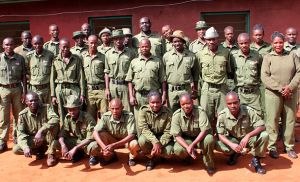
The rangers are proud of their land and their responsibility to protect it and the wildlife. I often refer to them as the “peace rangers” because they bravely patrol the 500,000 acres everyday unarmed. They are on the front lines of one of the most heated conservation battles, so intense that they’re the feature of an upcoming TV series on ivory poaching
We headed back towards the main office and made our way to the sustainable charcoal production area. Here, twigs and sticks no thicker than a finger are pruned from specific trees in certain areas, burned to char in barrels, and then compressed into bricks that burn more efficiently and at no cost to the nearby forests. This process addresses one of the root causes of deforestation in the area and creates a viable alternative through a small enterprise business opportunity.
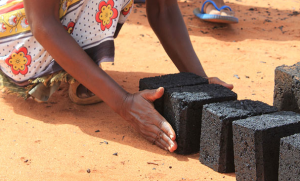
Sustainable production
In the days following, Lisa and I planned to see the rest of the project’s many elements, most of which provide sustainable employment for people of the community. We visited the local farms where agricultural intensification and reforestation initiatives are thriving, talked with locals doing community outreach, worked with the field team that monitors the trees and wildlife, and visited one of the most inspiring forms of job creation at the project, the Wildlife Works Eco-Factory. The factory is a source of great pride for the community, where dozens of locals make sustainable apparel items from organic and fair-trade cotton. These apparel items are sold directly to consumers or made for major companies like PUMA.
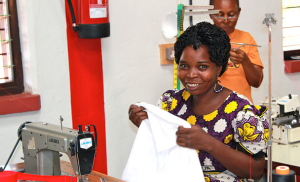
As big golden and orange rays of the sunset faded to dusk after our first day in the field, we made our way back to camp and were surprised by something precious along the way—a family of eight elephants at a Wildlife Works watering hole, displaying human-like tendencies as they used part of the structure to scratch their backs and bums! One of the smallest baby elephants I’d ever seen—no bigger than 4ft tall—clumsily swung his trunk around and tried to mimic his mother’s funny behavior.

It was a sweet moment to catch in the last light of day and one where I felt as if I were peering into the world of a family not that different from my own. We could only hope that this happy and healthy family would remain that as they were, free from the horrors of poaching that effect so many elephants.
Overall, Lisa and I had an incredible trip capturing the joy, progress, and meaningful changes happening throughout the 500,000 acres that comprises our REDD+ project in Kenya. When I talk to a company about purchasing carbon credits, it’s really so much more than a sale or a deal.
It’s proving to the world that with this long-term conservation model, rural communities can sustainably and organically grow, change, improve, and create the future they want while keeping the precious environment intact and living in harmony with the wildlife. I am hopeful and excited to participate and watch this incredible story unfold.
